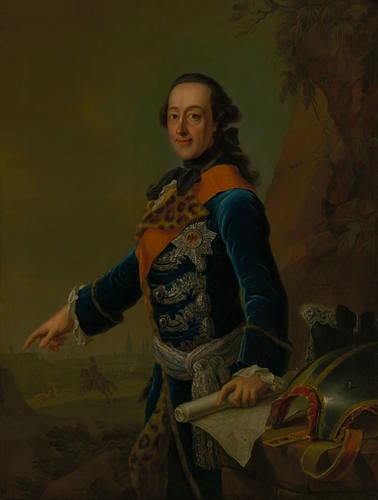Friedrich Wilhelm Ernst, Count of Schaumburg-Lippe (1724-1777) Signed and dated 1761
Oil on canvas | 143 x 109.6 cm (support, canvas/panel/stretcher external) | RCIN 405270
-
Nicknamed the "Kassler" Tischbein, Johann Heinrich Tischbein the Elder was the most successful member of the large Tischbein artistic dynasty. He first trained in Kassel under a wallpaper maker named Zimmerman. Then, in 1744, with the support of Graf Stadion, he became a pupil of Carl van Loo in Paris; and afterwards, in 1749, was apprenticed to Giovanni Battista Piazetta in Venice, where he spent time copying both Titian and Veronese. He returned to Germany in 1751 and became court painter in Kassel to Landgrave William VIII von Hesse; apart from a few short sojourns he remained in Kassel for the rest of his career.
At his best, Tischbein stands amongst the foremost portrait painters of the Eighteenth Century. Like Ziesenis, his style marks a transition between whimsical Rococo and the nascent Hellenic Classicism of theorists like Winckelmann. With the rise of Classicism towards the end of his career, his palette became darker and his mood increasingly more serious. As well as a substantial amount of portraits he also painted a number of mythological, religious and genre scenes. Notably, he provided paintings for Wilhelm VIII's so-called "Schönheitsgalerie" in Wilhelmsthal, his summer palace. He was particularly skilled in his portrayal of women.
Born in London, Count Friedrich Wilhelm Ernst of Schaumburg-Lippe was a grandson of George I and his mistress, Ehrengard Melusine von der Schulenburg. He fought in the War of Austrian Succession and sided with Prussia during the Seven Years' War. After his performance at the Battle of Minden he was rewarded with leadership of the entire allied artillery. He defended Portugal against Spanish invasion. A renowned military theorist, one of Count Friedrich Wilhelm's best-known slogans reads: "Kein anderer als der Defensivkrieg ist rechtmäßig!" ("Only defensive warfare is justified!") In this portrait he points towards a battle scene conducted before Münster in the background, holding a plan dated 1759 in his right hand.Provenance
Acquired by George IV; recorded in the Store at Carlton House in 1816 (no 271) and 1819 (no 288, valued at 15 guineas)
-
Creator(s)
(nationality) -
Medium and techniques
Oil on canvas
Measurements
143 x 109.6 cm (support, canvas/panel/stretcher external)
160.9 x 126.8 x 4.5 cm (frame, external)
Category
Object type(s)
Alternative title(s)
Frederick William Ernest, Count of Schaumburg-Lippe (1724-1777)








